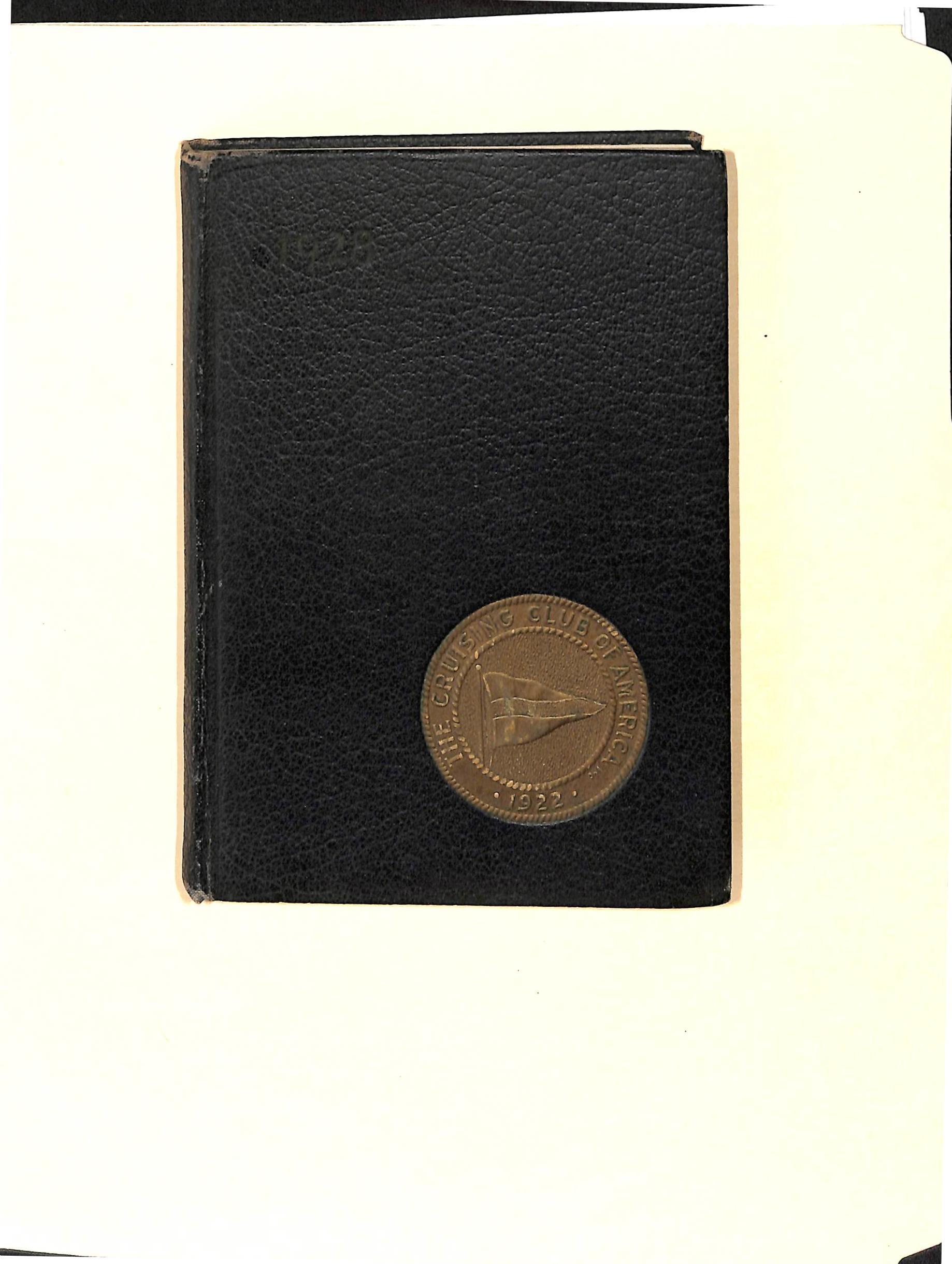

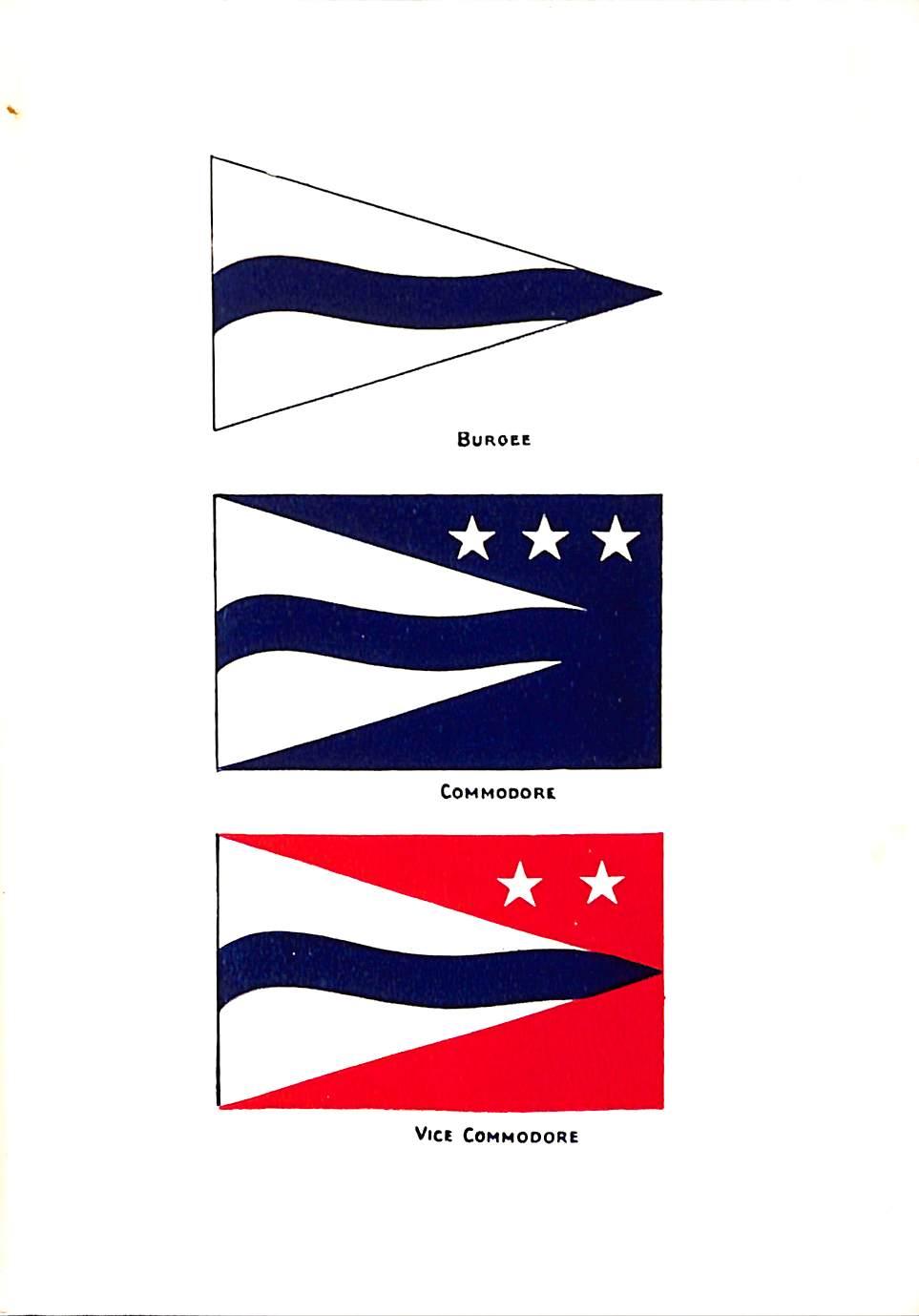
Rear Commodorks
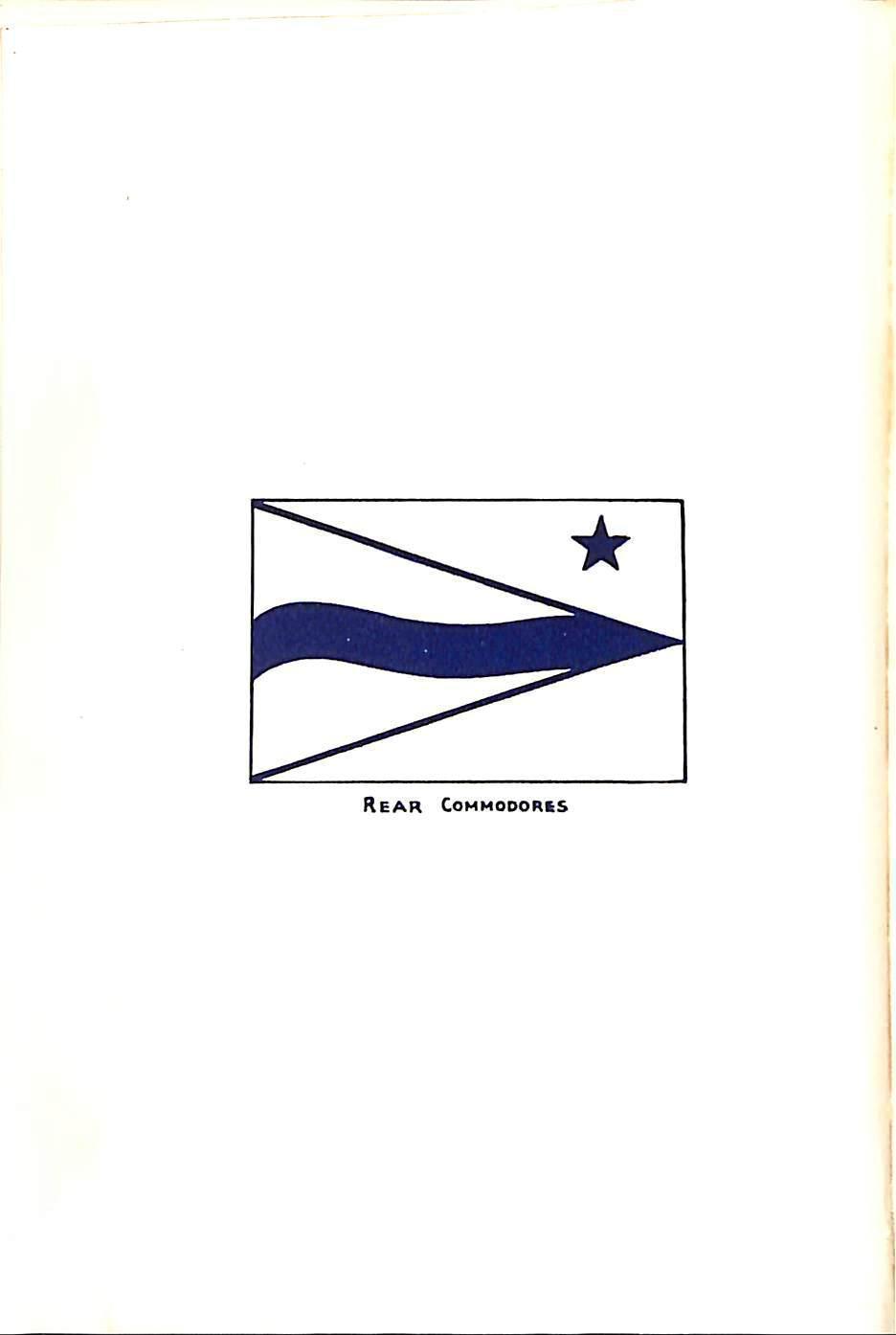





The Cruising Club of America was launched in the winter of 1921-22 by a group of yachtsmen interested in cruising and the development of the cruising type of yacht. It was felt that this branch of the sport never had attained the position it de serves in a country so rich in sea-going tradition and whose natural advantages are so peculiarly favorable to cruising, possibly because of the fact that there never has been any concerted action by cruising enthusiasts.
The yacht clubs of the country have made racing a large part of their activities and there are several inter-club associations devoted to the advancement of this branch of yachting, but there never has been in this country an organization comparable, for ex ample, to the Royal Cruising Club, which, in the last forty years, has done so much toward making cruising a national institution in Great Britain, so the Cruising Club of America was launched and it was but natural that its founders, familiar as they were with the work of the Royal Cruising Club, should have moulded it somewhat along the lines of the older organization.


1 928
Commodore
GEORGE P. P. BONNELL
Vice-Commodore
EDWARD CRABBE
Rear-Commodores
ALEXANDER W. MOFFAT
ROBERT H. MOORE
CHARLES B. DOWNS
Secretary-Treasurer
EDWIN H. TUCKER
Historian
W. P. STEPHENS
Governing Board
Class of 1929

B. H. INNESS BROWN
GILBERT D. MAXWELL
A. D. SEYMOUR. Jr.
HERBERT L. STONE
STUYVESANT WAINWRIGHT
Class of 1930
STEPHEN D. BAKER
JOHN SEWARD JOHNSON
MARTIN S. KATTENHORN
FREDERICK B. THURBER
ROGER YOUNG
1928
Membership
Ulysses D. Cutting, Chairman
Melville R. Smith
James K. Brugler, Jr.
Cruising Information
Martin S. Kattenhorn, Chairman
Allen T. Weeks
S. Elliot Cabot
Henry deForest Baldwin
H. B. Greening
Butler Whiting
Henry Howard
U. J. Herrmann
W. A. Wilson Alexander Neilaon Thomas P. Hammer
George H. Sistare
Design and Construction
Nelson B. Wolfe, Chairman
Charles D. Mower
Samuel Wctherill Awards
F. B. Thurber
W. P. Stephens
Henry Howard
Henry deForest Baldwin, Chairman
Ulysses D. Cutting S. D. Baker

Entertainment
Eldon H. Trimingham
Edward D. Payne, Chairman
John J. Atwater
Willard B. Cook
Hobart Ford
Race
C. Sherman Hoyt, Chairman
Alfred F. Masury
Edwin H. Tucker
Herbert L. Stone
Henry A. Jackson
G. N. Wallace
Edwin A. Jimenis
Charles D. Mower
Henry A. Wise Wood
Year Book
Henry A. Jackson, Chairman
Edwin H. Tucker
Herbert L. Stone
Alexander W. Moffat
Auditing
Gilbert D. Maxwell, Chairman
Charles W. Atwater
Foreign Relations
Henry A. Wise Wood
W. P. Stephens
Henry A. Jackson
Rear Commodore Alexander W. Moffat
Address Care of Walter Baker & Co., Inc. Pierce Square, Dorchester, Mass.
Telephone MILton I I 00
Regular Meetings: Lunch at 12:30 P. M. every Friday at Boston Yacht Club, 5 Rowe’s Wharf, Boston. Through the courtesy of Commodore Hodder the dining privileges of the Rowe’s Wharf Station are extended to all Cruising Club members.
The Boston Chapter of the Cruising Club numbers fifty members. Fifteen or twenty attend the Friday lunches, in formal meetings which reflect the keen interest of the organi zation in cruising craft and cruising information.
The following local committees for 1928 have been appointed:

Membership: George B. Doane, Chairman, P. O. Box 5253, Boston. Mass., Joseph Guild, Alex. S. Neilson.
Cruising Information: Alex. S. Neilson, 85 Spooner Road, Chestnut Hill, Mass. Teleph one REGent 1875 or (office) LlBerty 2021.
June 19 Auxiliary Race, New Bedford-New London, 150 Miles
George S. Sistare, Chairman, 474 Park St., New Bedford, Mass., William H. Coolidge Jr., William H. Hand, Jr., Frank Vining Smith, Allen T. Weeks.
September 8 Auxiliary Race, Gloucester Course, 130 Miles
William H. Coolidge Jr., Chairman, 50 Congress St., Bos-
ton, Mass., George B. Doane, Frederick Gardiner. Joseph Guild, George H. Sistarc, Frank Vining Smith, Harl P. Stetson. an
Not the least interesting of the activities of the Boston Chapter have been in winter quarters at the Victory Yacht Yard, Squantum, Mass. Here in the six 350ft wet slips in which new destroyers were fitted out during the War are basined many of the Cruising Club fleet. The great glass and steel structure which completely houses the wet slips permits the entry of a fifty foot mast at low water. Taller unsteppcd at the doors, or the vessel careened while entering. On Saturday afternoons and Sundays throughout the winter a warm cabin and a warm welcome can be found aboard
masts are many a craft which has heretofore been canvassed and ignored for the winter in a bleak boat yard.
Among others of the Cruising Club in the wet slips are HOUQUA, MEDRIC, SEA LURE, HEART'S DESIRE. MONHEGAN and WANDERER.
It has been customary in the fleet of the Boston Chapt to fl y the burgee of the Cruising Club by day and night.
sum¬ mer and winter. new one.
It is taken in only to be replaced by a In making colors in a yacht anchorage the private signal conforms to the gun signal but the Cruising Club burgee stays aloft.
May 30th a on Cove.
Following the practice established in previous years the Boston Chapter holds one winter dinner, and rendezvous afloat which is usually held in Smith's Gloucester.

"As long as seamanship is the primary qualification for membership it is of no importance to the Boston Chapter whether its numerical strength shows growth."
Rear Commodore: Robert H. Moore, P. O. Bo
L. I., Phone, Huntington No. 4.
74, Halesite, X
Secretary: William RusKmorc. 187 Park Avenue, Huntington, L. I., Phone, Huntington 1804
Membership Committee: Kenneth Stephens, 53 Beaver Street, New York City; William T. Haskell. Ricliards Road, Port Washington, L. 1.; W. E. Baker, P. O. Box 97, Moriches, L. 1.

The Huntington Yacht Club is an official Cruising Club Station and flies the Club Burgee. Cruising Club members may leave their boats at the Club for indefinite periods. It will be cared for by the Club attendant, riding lights set, sails dried, etc. at a small fee. George Bonncl is loaning two bouys which will be placed in the lower cove and available for midweek moorings.
There are three yacht yards in Huntington and two gas Gas, water and small supplies may be engine repair men. gotten at the Huntington Yacht Club, which also has the best restaurant on the North Shore of Long Island.
Rear Commodore: (Vacancy caused by the death of Ogden T. McClurg not yet filled.)
In corresponding, address R. P. Benedict, c/o Darling & Co., 4201 Ashland Ave., Chicago.
Chairman Local Membership Committee: U. J. Herrmann, Cort Theatre, Chicago, 111.
Rear Commodore: Charles B. Downs, 1615 Pennsylvania Bldg., Philadelphia, Pa.
Membership Committee: E. W. Madeira, c/o U. of Penna. Philadelphia, Pa.; T. P. Hammer, W. Findlay Downs.
Information has been received that moorings for use of members have been established at the harbors listed. Other than stated below no record is available of the character, condition or size, and members using same do so at their own risk.
Crocketts’s Cove, Me.
Pleasant Point, Me.
Thomaston, Me.
Smith's Cove, Gloucester, Mass.
Onset Bay, Mass.
Padanaram Harbor, So. Dartmouth, Mass.
Lloyds Harbor, N. Y.
Rye. N. Y.
Donald Moffat
Wilbur Mor?;e
Charles Morse
Sherman Tarr
I'i. S. Parkhurst
George H. Sislare
Huntington Station
American Y. C.
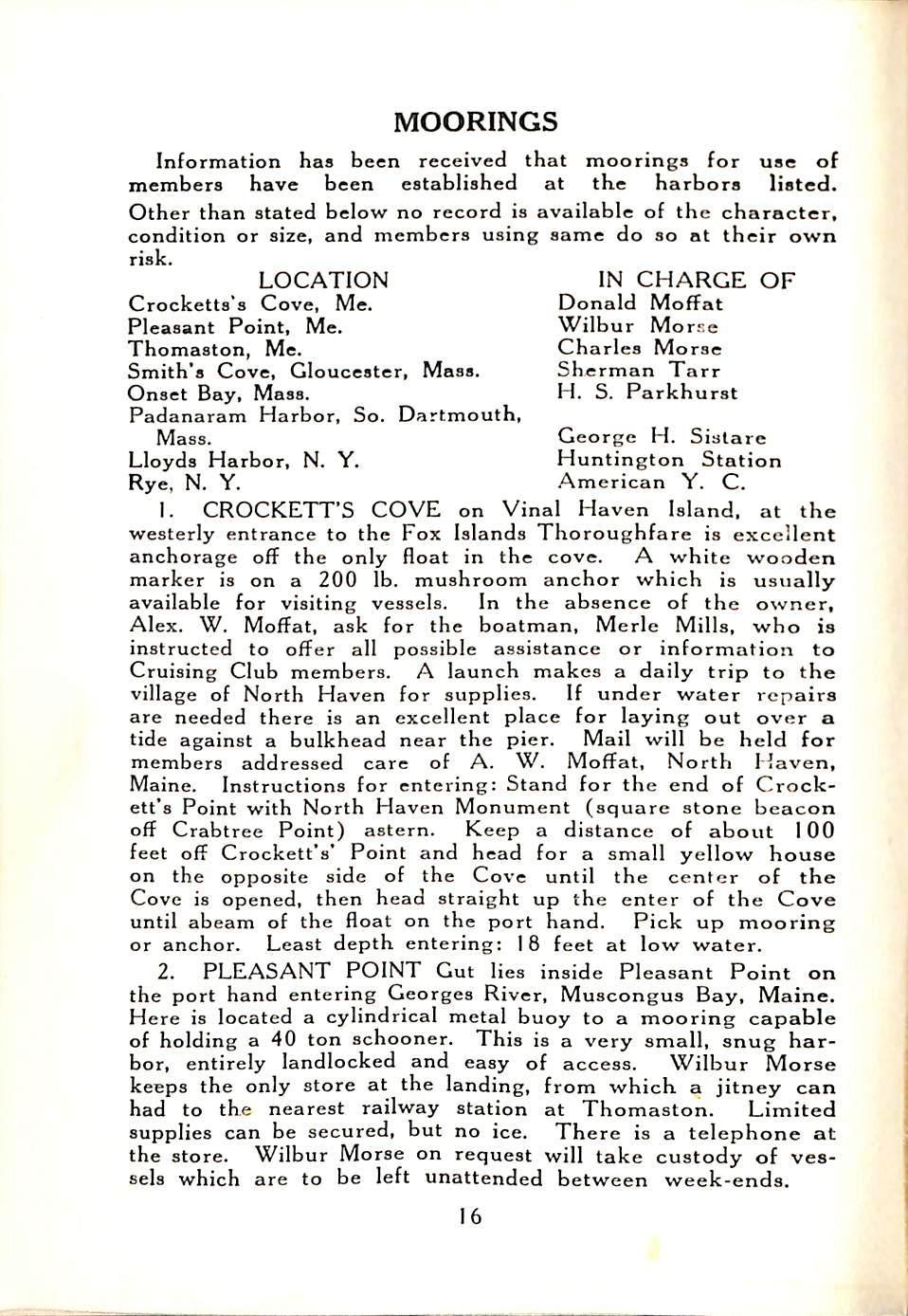
on Vinal Haven Island, at the westerly entrance to the Fox Islands Thoroughfare is excellent anchorage off the only float in the cove. A white wooden marker is on a 200 Ib. mushroom anchor which is usually available for visiting vessels. In the absence of the owner, Alex. W. Moffat, ask for the boatman. Merle Mills, who is instructed to offer all possible assistance or information to Cruising Club members. A launch makes a daily trip to the village of North Haven for supplies. If under water repairs are needed there is an excellent place for laying out over a tide against a bulkhead near the pier, members addressed care of A. W. Moffat, North Haven, Maine. Instructions for entering: Stand for the end of Crock ett's Point with North Haven Monument (square stone beacon off Crabtree Point) astern. Keep a distance of about 100 feet off Crockett’s' Point and head for a small yellow house on the opposite side of the Cove until the center of the Cove is opened, then head straight up the enter of the Cove until abeam of the float on the port hand. Pick up mooring or anchor. Least depth entering: 18 feet at low water.
2. PLEASANT POINT Gut lies inside Pleasant Point the port hand entering Georges River, Muscongus Bay, Maine. Here is located a cylindrical metal buoy to a mooring capable of holding a 40 ton schooner. This is a very small, snug har bor, entirely landlocked and easy of access. Wilbur Morse keeps the only store at the landing, from which a jitney can had to the nearest railway station at Thomaston. Limited supplies can be secured, but no ice. There is a telephone at the store. Wilbur Morse on request will take custody of ves sels which are to be left unattended between week-ends.
3. THOMASTON, Maine offers anchorage and wharf faci lities at the yard of Charles Morse on the starboard side of the harbor just below the bridge. Usually one of the yard moorings are available. There is a strong scour of tide, supplies and repairs arc available, as well as custody of boats.
4. GLOUCESTER. There is a mooring with a cylinderical metal buoy painted Cruising Club colors, white with a wavy blue line around it, located in Smith’s Cove, Gloucester Harbor, off the pier of the Rocky Neck Railways, of which Sherman Tarr is the proprietor. A staff is located on his office which flies all summer a large Cruising Club pennant. He is always most obliging, and will render any assistance which a good shiprd is capable of, including telephone facilities and handling il for members. Address, c/o Rocky Neck Railways, East
All responsible ya ma Gloucester. Mass.
5. ONSET BAY. At the head of Buzzard's Bay mooring facilities are usually available at the yard of H. S. Parkhurst the starboard side of the harbor. The anchorage is llent and protected for small craft but should not be ed by vessels drawing more than 7 feet. Facilities for pplies are inconvenient but responsible custody for boats well as excellent repairs may be obtained.
on exce us su as na
6. PADANARAM Harbor. Mr. Gilbert Maxwell has do ted a mooring to the Cruising Club which is in care of Mr. George H. Sistare who may be located through the New Bed ford Yacht Club Station in the harbor, mushroom anchors the mooring which is marked by a can with the Cruising Club stripe on top, located NxW from the first red channel buoy after passing the breakwater and bears W |/2 S from the center of the gray barn on the east shore. A rock with 4 feet of water on it bears NExN Yi N distance 120 feet from Supplies of all kinds are easily available at So.
There are two onto of 300 and 350 lbs. bridled the mooring.
7.
Oartmouth. LLOYDS HARBOR. On the south westerly side of Huntington Harbor, north shore of Long Island. N. Y., two moorings painted with Club Colors, in charge of Huntington Station, are maintained by the Club. No supplies nearer than Halesite (Huntington) or Northport. At both of these places ice, water, and all provisions can be obtained.
8. RYE. On north westerly side of Long Island Sound at Rye, N. Y. there is a mooring, painted with club colors main tained by American Yacht Club. Ice, water and some sup plies can be obtained through courtesy of this club._ Nearest town and railroad station. Rye, hour's ride from New York. (NOTE: Information on moorings 1-6
N. Y. & H. R. R. an on furnished by the Boston Station) was 17
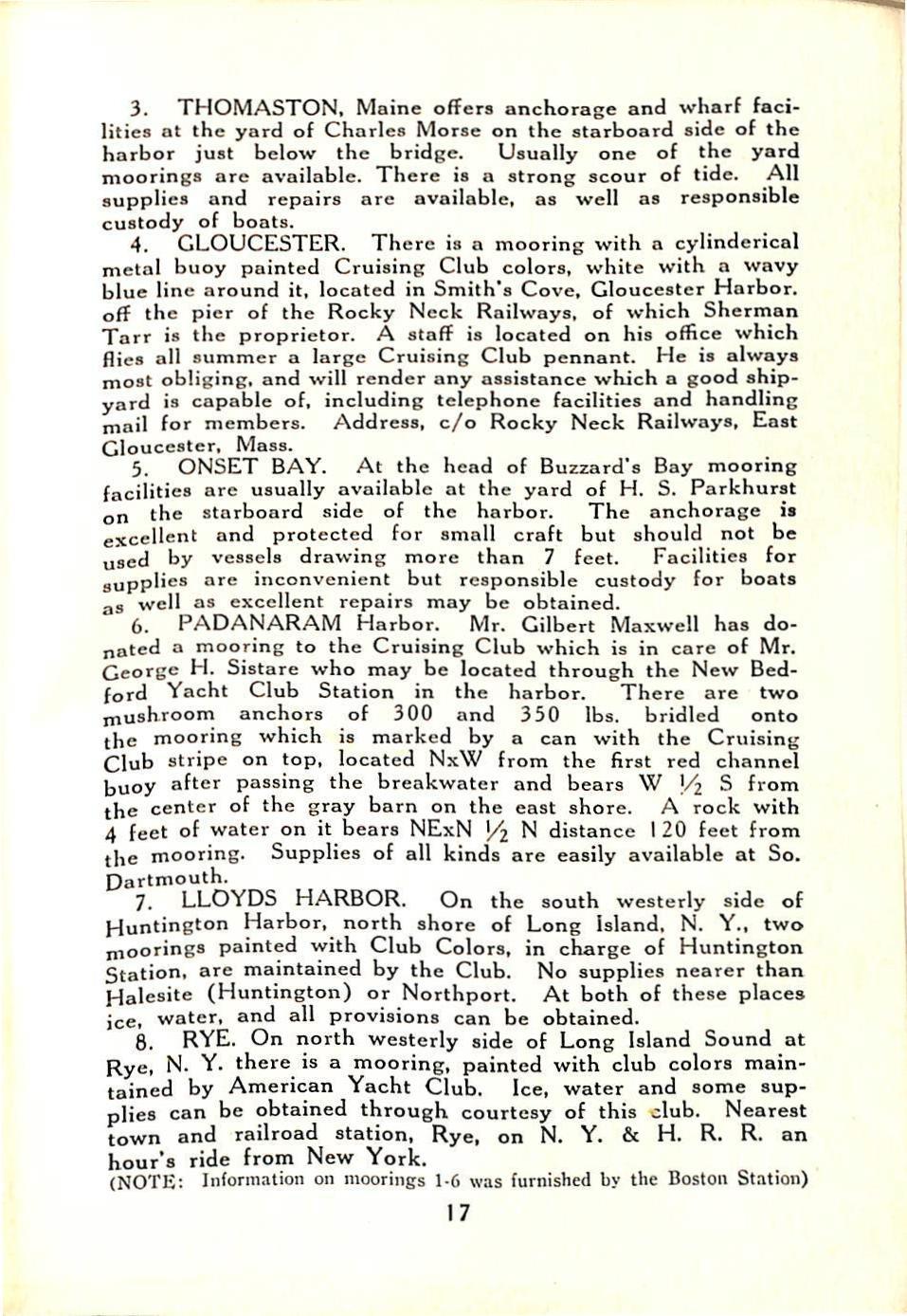
Adopted November 19. 1924. Amended to January 13. 1927.
The name of this organization shall be "The Cruising Club of America, Inc.”
The objects of this Club are to promote cruising by amateurs, to encourage the development of suitable types of cruising craft, to stimulate interest in seamanship, navi gation and handling of small vessels, to gather and keep on fi le all information which may be of assistance to mem bers in cruising.
Commodore, Vice Commodore, Rear Commodores, Sec retary-Treasurer and Historian, who with ten members shall constitute the Governing Board.

The Commodore shall be the general executive officer and preside at all meetings.
The Vice Commodore shall assist the Commodore in the discharge of his duties and in his absence act in his stead.
The Rear Commodores shall command their stations and perform such other duties as assigned to them by their superior officers and the Governing Boarfl.
The Secretary-Treasurer shall perform all the proper duties pertaining to those offices.
The Historian shall each year write a I,og of the Club’s activities during the past year and present same at the annual meeting.
The Governing Board shall have the powers of Directors and general charge of all matters pertaining to the man agement of the Club.
Any amateur who has proven his ability to handle and navigate a yacht or small vessel, and has had sufficient cruising experience, shall be eligible to membership.
All applications for membership must be on forms ap proved by the Governing Board. Applicant’s name must be proposed by one member and seconded by two others
to whom he must be personally known, and a letter from each must accompany application stating qualifications, and that they believe him to have had proper cruising experi ence. .\pplicant will fill in questionaire giving sucli in formation as is necessary to determine his qualifications. After approval of tlie application by the Governing Board (on receipt of report from Menibersliip Committee if one be appointed) the applicant’s name shall be sent to all members, and at the expiration of thirty days, the applicant may be admitted to membership by the Governing Board.
●Ml resignations must be in writing and sent to the Secret ary-Treasurer.
There shall be three classes of membership, regular, life and honorary. A member may become a life member by payment of the fee and thereafter is exempted from yearly dues. Honorary members shall have no vote nor hold office except that of Historian, but otherwise shall enjoy all privileges of regular members.
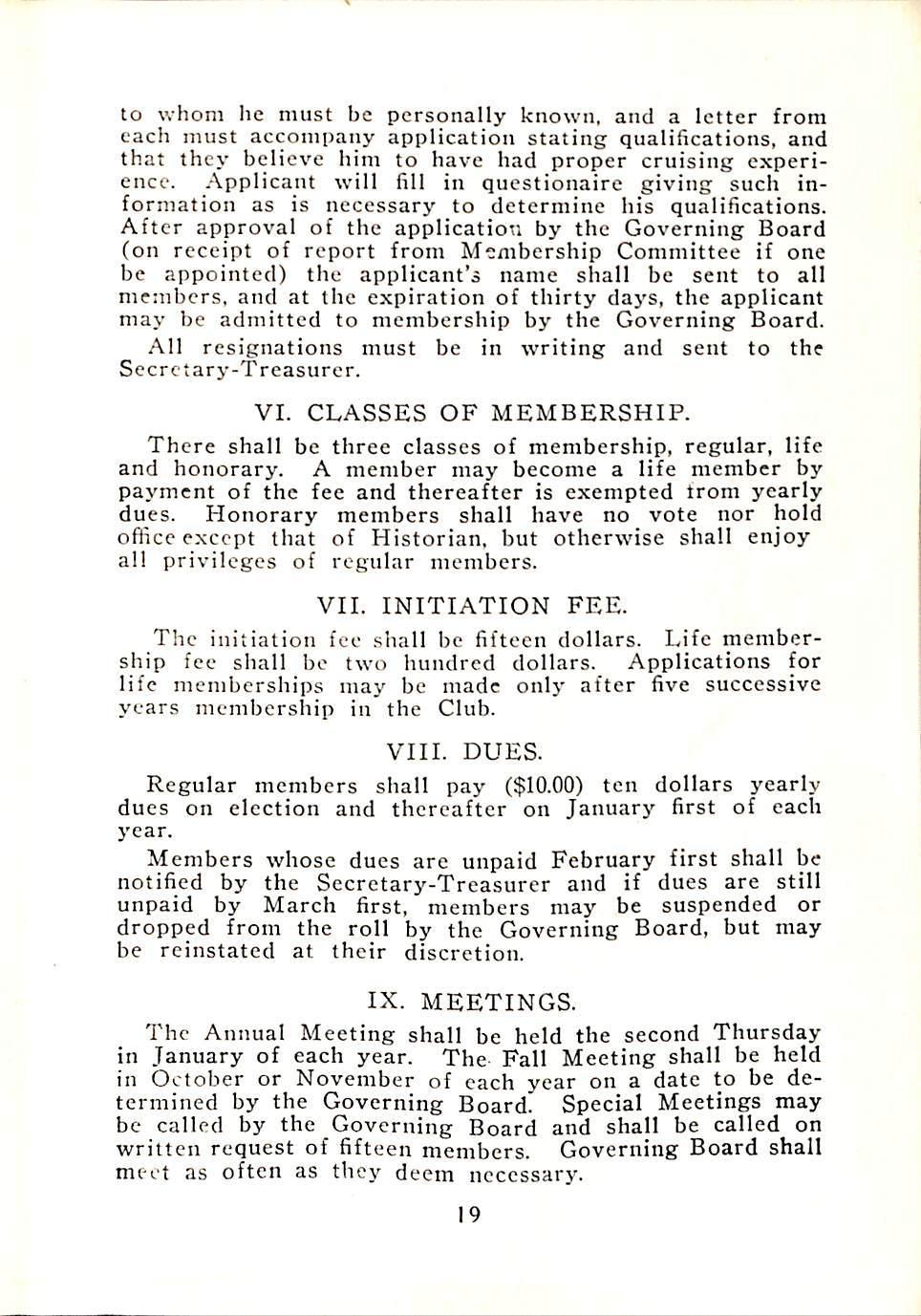
The initiation lee .shall be fifteen dollars. Life member ship fee shall be two hundred dollars. Applications for life memberships may be made only alter five successive years membership in the Club.
Regular members shall pay ($10.00) ten dollars yearlydues on election and thereafter on January first of each year.
Members whose dues are unpaid February first shall be notified by the Secretary-Treasurer and if dues are still unpaid by March first, members may be suspended or dropped from the roll by the (governing Board, but may be reinstated at their discretion.
The Annual Meeting shall be held the second Thursday in January of each year. The Fall Meeting shall be held in October or November of each year on a date to be de termined by the Governing Board. Special Meetings may be called by the Governing Board and shall be called on written request of fi fteen members. Governing Board shall meet as often as they deem necessary.
Twenty-five members present in person or l>y proxy shall constitute a quorum at any meeting of the Club. Five members shall constitute a quorum at any meeting of the Governing Board.

At the Fall Meeting a Nominating Committee of five shall be elected, none of whom shall be a member of the Governing Board.
This Committee shall nominate one candidate for each office to be balloted for at the Annual Meeting, notifying the Secretary-Treasurer of same not later than December first.
All independent nominations must be filed with the Secretary-Treasurer at least ten days Ijeforc the date of the meeting, and notice of same shall be sent to members by the Secretary-Treasurer, at least fi ve days before the meet ing.
Commodore. Vice Commodore and Sccretary-Trea.surcr shall be elected at Annual Meeting and hold office for one year or until election of their successors.
Five members of the Governing Board shall be elected at Annual Meeting and hold office for two years or until election of their successors.
Vacancies in elective officers shall be filled by the Gov erning Board and hold office till next annual meeting.
The Governing Board shall appoint such Committeea as they deem necessary.
The chief station of the Club shall be in New York City, but wherever four or more members reside in any locality, they may found a station, giving notice to the Secretary, who shall notify the other members of the Club.
Each station shall be under command of a Rear Commo dore elected by the members of the station.
The fl ag shall be triangular in the usual proportion with white field and a waved blue stripe 20'^o of the hoist in width running through the center from hoist to point.
The Commodore's flag shall be rectangular in the usual proportions, and consist of the Club Flag with the outer triangle corners in blue, with three white, fi ve pointed stars placed laterally in the upper outer blue triangle.
The Vice Commodore's flag shall be similar to the Com modore’s except that the outer triangles shall be in red and have two fi ve pointed white stars in upper outer red triangle.
The seal of the Club shall be its flag surrounded by a double circular rope border between which shall be the lettering on the upper part “The Cruising Club of America, Inc.’’ and date of founding “1922'' on the bottom.
No expenditures of funds nor contracts binding Club shall be made except by authorization of the Governing Board.
Every member on joining the Club impliedly undertakes to comply with this Constitution and By-Laws and any re fusal or neglect to do so. or any conduct unworthy of a gentleman or sailor, or inimical to the welfare of the Club, shall render such member liable to suspension or ex pulsion by a majority vote of the Governing Board.

Notice of such proposed action, with reason therefore, must however be sent to the accused member by registered mail to his last known address at least thirty days prior to the meeting, and accused member shall have the right to be present at the meeting with counsel.
This constitution cannot be suspended under any cir cumstances but may be amended by a two thirds vote at Annual or Fall Meeting.
Proposed amendments must be in writing signed by five members and sent to the Secretary-Treasurer in time to be included in the notice of the meeting.
Adopted November 19, 1924.
The order of business at all Club meetings shall be as follows:
Roll Call
Minutes of previous meeting
Report of officers
Reports of committees
Unfinished business
Elections
New business
In case of dispute as to order or debate, Cushing’s Man uel shall govern.
Notices of Annual and Fall Meetings shall be sent to each member at least twenty days previous thereto. Notice for Annual Meeting must contain report of Nomina:ing Committee. Notices of special meeting shall be sent to each member at least fifteen days previous thereto, and shall state in detail the subjects to be brought up for action and no other matters mav be considered.
III.
A member shall have the right of appeal to the Club, from a decision of the Governing Board, which may be overruled at the next regular meeting by a two-thirds vote of those present, or by proxy. Notice of such appeal must be stated fully in the call for the meeting.

IV.
None but members shall be allowed in the meeting room during a meeting of the Club.
Every member present when a motion is under con sideration shall vote thereon unless excused by the pre siding officer.
Proxies must be in writing, signed, witnessed and fi led with the Secretary-Treasurer five days in advance of the meeting.
These By-Laws cannot be suspended under any circum stances but may be amended by a two-thirds vote at Annual or Fall Meeting.
Proposed amendments must be in writing signed by five members and sent to the Secretary-Treasurer in time to be included in the notice of the meeting.


Ackerly, S. Le Roy

Alden, John G.
Alker, James W.
Ames. Frederick L.
Amory, Harold
Armstrong, Daniel W.
Atwater, Charles W.
Atwater, David H.
Atwater. John J.
Austin, Harry
Bacon, Daniel
Baekeland, Dr. L. H.
Clair L.
Henry Martyn
William £., Jr. Baldwin, F. W.

Cronkhite, Minton
Curtis, S. P. Curtis, William J. Jr. Cutting, Ulysses D.
Davis, Charles G.
Dc Posch. Lionel A.
Dickerson, John S.
Dillon, Schuyler
Doanc, George B.
Downs, Charles B.
Downs. W. Findley

Drake, George B.
Draper, Frank B.
Duggan, George H.
Durant, Donald
Durant, Wallace L.
Duryee, Andrew Barr
Dyer, Leonard H.
Farmer, Thomas Jr. Farnsworth, George B.
Fenger,

Forbes,
Foster,


●
Nicholson, Paul C.
Nield, Charles F.
Herbert B.
Parkinson, John
Parkman, Henry, Jr.

Payne, Edward D.
Percivnl, Lawrence F.
Perkins, Frederic W.
Perry,
Rice, Dr. George E.
Linton
Riggs, Dr. Austin Fox
Rowland,



Owl II
Pinta (Aux.)
Privateer (Aux.)
Radiant (Aux.)
Roaring Bessie
Sachem (Aux.)
Sagamore (Aux.)
Seafarer
Sea Lure (Aux.'
Surprise
Swastika (Aux.‘)
Teal (Aux.)
Tigress (Aux.)
Vanguard (Aux.)
Venona II
Volador (Aux.)
Wanderer (Aux.)
Whistler (Aux.)
New York, N. Y. Rye, N. Y.
111.
Zodiac

(Aux.)
Boston,
R. 1.
L. I.
N. Y.
Bank, N. J.
Mass. So. Dartmouth, Mass.
Toronto,
New

Alice (Aux.)
Caroline (Aux.)
Comeawa (Aux.) Cynosure (Aux.)

Dragoon (Aux.)
Felisi (Aux.)
Glencairn
Home Port
Newport, R. I.
Rye, N. Y.
Patchogue, L. I.
St. Petersburg, Fla.
New Rochelle, N. Y.
Middletown. Conn.
Montreal
Boston, Mass.
Seattle, Wash.
Boston, Mass.
Owner
H. Howard
William J. Curtis, Jr.
Frank Bannerman
Geo. S. Gandy, Jr.
R. N. Bavier
T. M. Russell
G. H. Duggan
Alex. W. Moffat
O. C.
Melody (Aux.)
Puffin II (Aux.)
Rival HI (Aux.) Spindrift (Aux.)
Chas.
S.
Stuyvesant

Lorna (Aux.)
Magpie (Aux.)
Manhasset II
Merla
Monhegan (Aux.)
Naaman (Aux.)
Nameless (Aux.) Ogailala
Old Glory (Aux.)
PinaFore (Aux.)
11 (Aux.)
Scrapper 111

Catch
Tom



Feeling that the small boats, and frequent examples ship displayed by amateur sailors of all nationalities that went
re were many noteworthy voyages made in or meritorious seamanunrecognized, it seemed to the members of the Cruising Club of America that this organization properly record and reward such adventure was the fitting one to upon the sea.
Therefore, at the annual meeting on February 27, 1923, the following resolution was passed, founding a medal that, it was hoped, might prove an incentive for carrying on the spirit of adventure and upholding the best traditions of faring that seaheritage from the past are our
out of
Water Medal of the Cruising ue year s rers of
"Moved and seconded that the Club found, funds to be sought for the purpose, a medal to be known as The B1 Club of America, to be awarded annually, in the discretion of the Board of Governors, for the most meritorious example of seamanship, the cipient to be selected from among the amateu all the nations.”
In pursuance of this resolution a suitable medal, five inches in diameter, was made, the design being by the late Arthur Sturgis Hildebrand, a member of this club and one of the crew of the yacht Leiv Eiriksson, lost in the Arctic with all September 1924. hands in

The BIue Water Medal for 1926 was awarded to Lieut, in that E. G. Martin, of London, England, who Commander year sailed the cutter Jolie Brise from Falmouth, England, to Larchmont, New York, thence back to Plymouth, England, via Bermuda, compieting a double crossing of the Atlantic three months and 24 days, during which the little yacht covered 9,600 miles—a most creditable performance.
in
In the opinion of the Committee Awards this on voyage in the hand- reflected a high degree of seamanship, not only i ling of the vessel at sea during the two long passages, but also in her fitting out and equipment, been carried out with Seldom has a yacht voyage as careful and intelligent planning, been executed in a more seamanlike manner. In consequence of which no damage of any character to vessel, sails
or or gear was sustained, although several hard gales were encountered and weathered.
The following brief outline of the voyage is given by the owner and master of the Jolie Brise:

■■Jolie Brise was built at Havre, France, in 1913 by Pau(which was launched a few weeks later) of the famous Pilot Boats turned out by this designer and builder. I bought her in 1924 and refitted her. In 1925 she won the fi rst Fastnet Race. In 1926 1
melle, and was the last but one gave her a trisail rig and a square rig, and other gear necessary for 44
crossing the Atlantic, and sailed for America, leaving Falmouth crew consisted of myself, owner and skip per; J. R. K. Warneford, mate and navigator; J. Weston Martyr, and S. Briggs and J. Green, paid hands.
April 3rd. The on 1
”I started without anyone knowing our destination, as an unbroken passage to New proposed to make, if possible, York by the Southern route used formerly by square-rigged ships. This passage takes one down the coast of Spain and Portugal, east of Madeira and west of the Canary Islands, thence southwesterly to about 20 degrees North, in order to avoid the calm areas which lie north of that. The Atlantic d between Latitudes 19 degrees and 20 degrees until a position about 250 miles east of the West Indies and 700 miles southward of Bermuda was reached. The ships

was Crosse head was then turned in a northwesterly direction so as to pass Westward of Bermuda, cross the Gulf Stream diagonally, was carried The programme and so make Monlauk Point chored in Larchmont Har. out as intended, and Jolie Brisc an bor on May 20th, 47 days, 2 hours out from Falmouth, having sailed a distance of 6,000 miles.
“The incidents of the voyage were a moderate gale from southwest in the Bay of Biscay on the 6th and 7th of April, hove to in a very big, but not really had to heave during which ship was dangerous sea we Again on to in a moderate southwesterly gale, afternoon, the wind came northeast, and quarter from Latitude 40° 26’ until we were
the 10th of April
Next day, in the late carried it in that we Latitude 19° 10', and so right across the Atlantic.
“We region of the Canaries, where we Thence to the tropics they steadied down to a which, with occasional light patches, remained wonderfully rthward into the Horse Lati- constant until we turned no
picking up what really were exceedingly lucky in were the northeast trades off the Portuguese coast in April. As we proceeded south they blew strong, to a gale at times, and were strongest passing down the African coast and in the had a heavy following sea. fresh breeze.
the wind. re
tudcs, couth of Bermuda. Our run, dead befo was about 3,500 miles in length; and the square rig only was used for practically the whole of this distance.
es we ream we were caught in a violent gale from the northwest i the sea became dangerously high, and very steep for its size. We measured a number of waves with
“In the Horse Latitud had very trying weather— calms, occasional strong winds from any direction, and squalls. Soon after we struck the southern edge of the Gulf St
in which a very sensitive height recording aneroid, which gave readings of from 46 feet to 52 feet (maximum), through to crest, high 1 believe them to be accurate. Tho ugh these figures The ship made about the 24 hours, and came through it,
are 80 miles drift southwest i n
hove-to, without the slightest damage on deck. Thereafter the weather fi ne shipping any water or d away and uneventful passage to Larchmont.. had we an
in New London in the Bermuda race on June 20th. the ship sa race she
“We remained i Long Island Sound until we started from In this
iled creditably, particularly considering that was laden with ocean stores and was from four to fi ve inches below her sailing trim.
“We refitted in H. M. Dockyard at Bermuda and sailed thence for England on July 3rd.

voyage with the addition of R. M. Buckley and George Gallowhur. After some calms
Crew same as outward we encountered very strong fair winds in which we ran for two nights under bare pol much oil. es, using We steered a northerly on a Great Circle track in order to reach coole
course ther.
From the tail of the Banks for
No seas came aboard. r weasome time we exper
ienced foggy weather and light winds which would have made the passage a slow one had it not been for fresh northwest winds towards the latter part of it. jolie Brise anchored in ur days from BerThe round voyage totalled
Plymouth Sound on July 27th, twenty-fo muda, having sailed 3,000 miles. between 9,600 and 9,700 miles.
"I think the most remarkable feature of the cruise was that wc came tlirou^jh without the loss of any sails or gear, except some of the squaresail gear which chafed through on the outward voyage and had to be renewed from time to time. 1 attribute this to the strength of the gear and to the extra ordinarily easy motion of the ship in bad weather—and also to good fortune. To my mind, the great feature of the voy age was the accuracy of the navigation, in charge of Warneford. We always knew the position of the ship exactly, ex cepting perhaps for some hours during the gale in the Gulf Stream, and our landfalls were dead accurate. 1 had no part in the navigation except the care and handling of the wireless receiving sets. These were specially fitted for the trip, and ignals continuously throughout the The maximum distance at which a signal was Lafayette (Bordeaux. France) at about 4,200 American and European signals overlapped by about single Waltham chronometer (8 day. small Iways knew the time to within one made possible Warneford’s extremely accurate

with them 1 got the time si round trip, received was miles. ten days, size) and we a
1 had a -half second. This, of course, navigation.
sailed for eighteen days without
‘‘During the voyage we sighting another vessel when running down the Trades, nly three and we were
ighting Palma to Montauk Point, out
In the following fifteen days we saw o thirty-three days, from si of sight of land.
ill be found the principal dimensions of the "Below Jolie Brise:
"Cutter. 56 feet over all; 48 length water line: 15 feet 9 beam: draft 10 feet; sail area 2,600 sq. ft.: ballast 4,200 lbs. iron on keel; 43,000 lbs. iron inside (approx.). Displacement about 50 tons (normal): displacement about 55 tons i atlantic trim and during the New London-Bermuda Race .
E. G. MARTINin Trans-
The loss of the LEIV EIRIKSSON and the efforts that were taken to find trace of her will be found on pages 40-48
1926 Year Book.

LEIV EIRIKSSON
Lost in the Arctici
September 1924

With shipmates our
WILLIAM WASHBURN NUTTING
ARTHUR STURGIS HILDEBRAND
JOHN O. TODAHL
OTTO FLEISCHER

^lue Water Wledal
(Yarn of s'ovage in 192/ ^’eal● Book)

(Yarn of voyage in 1927 ^'ear Book)
















 Yankee Girl George \V. Warren Windjammer Edivard Crabbe
Yankee Girl George \V. Warren Windjammer Edivard Crabbe


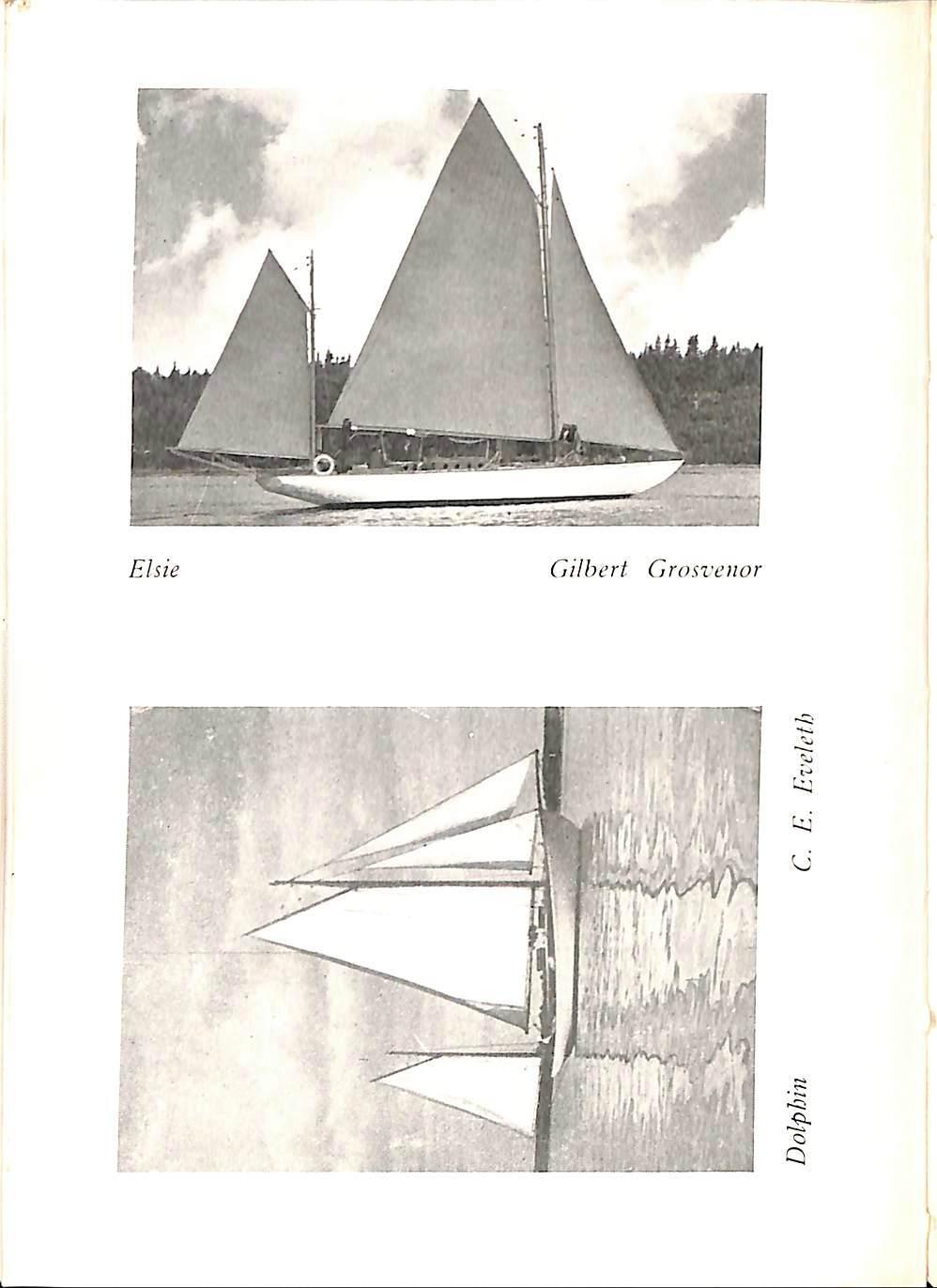
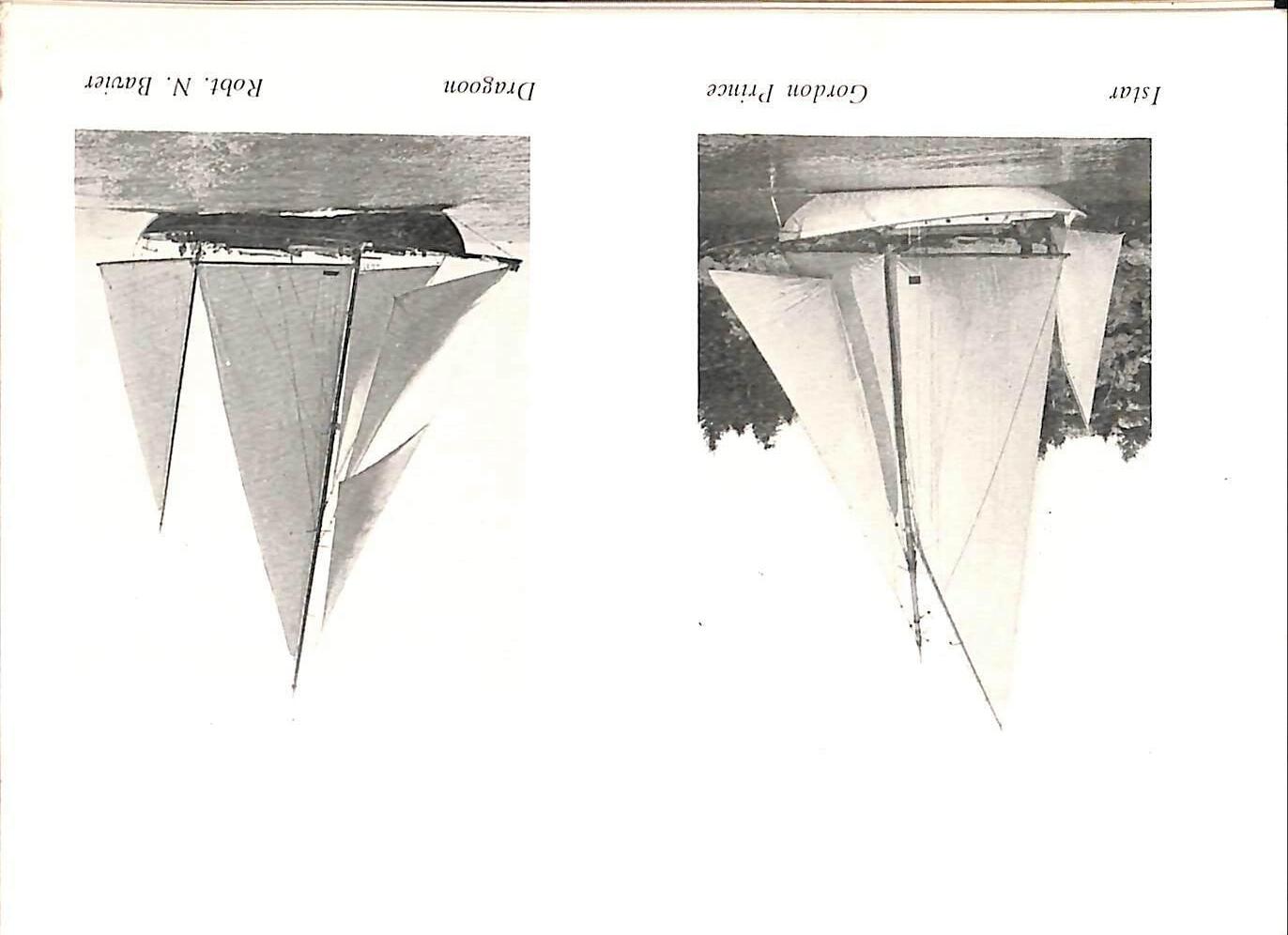








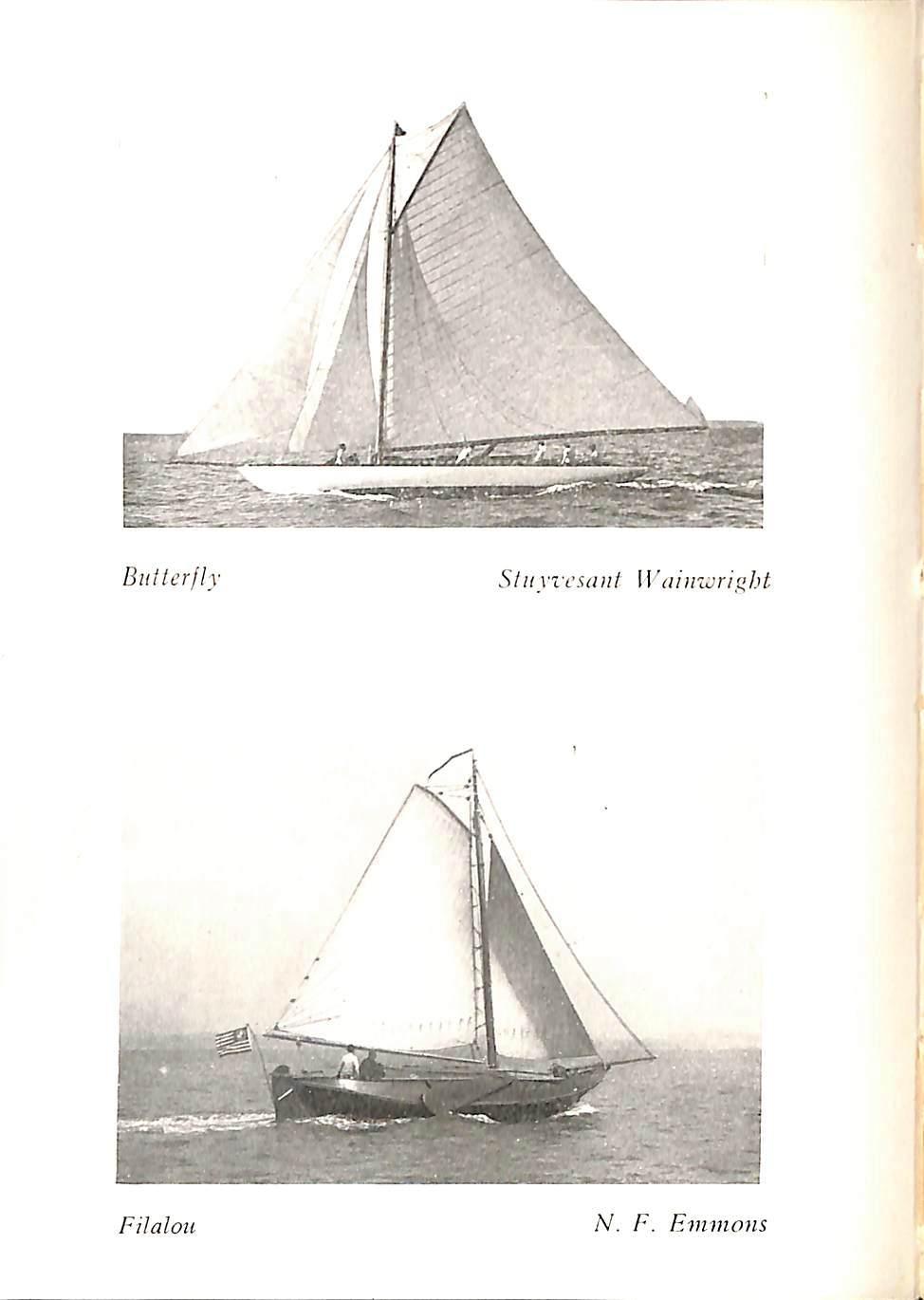
 G. II. Sistare
Duckling
Edna
C. W. Atwater
G. II. Sistare
Duckling
Edna
C. W. Atwater
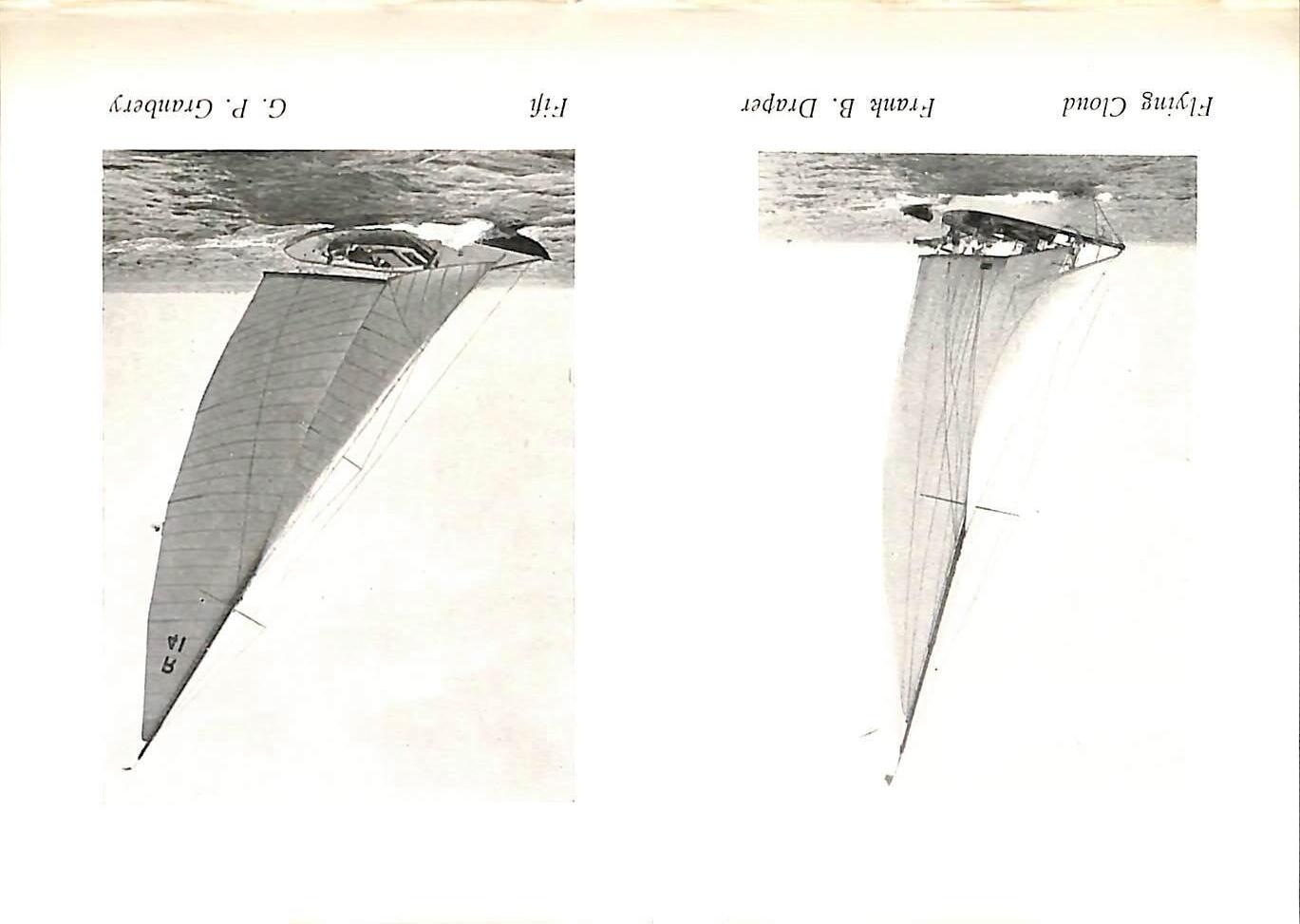

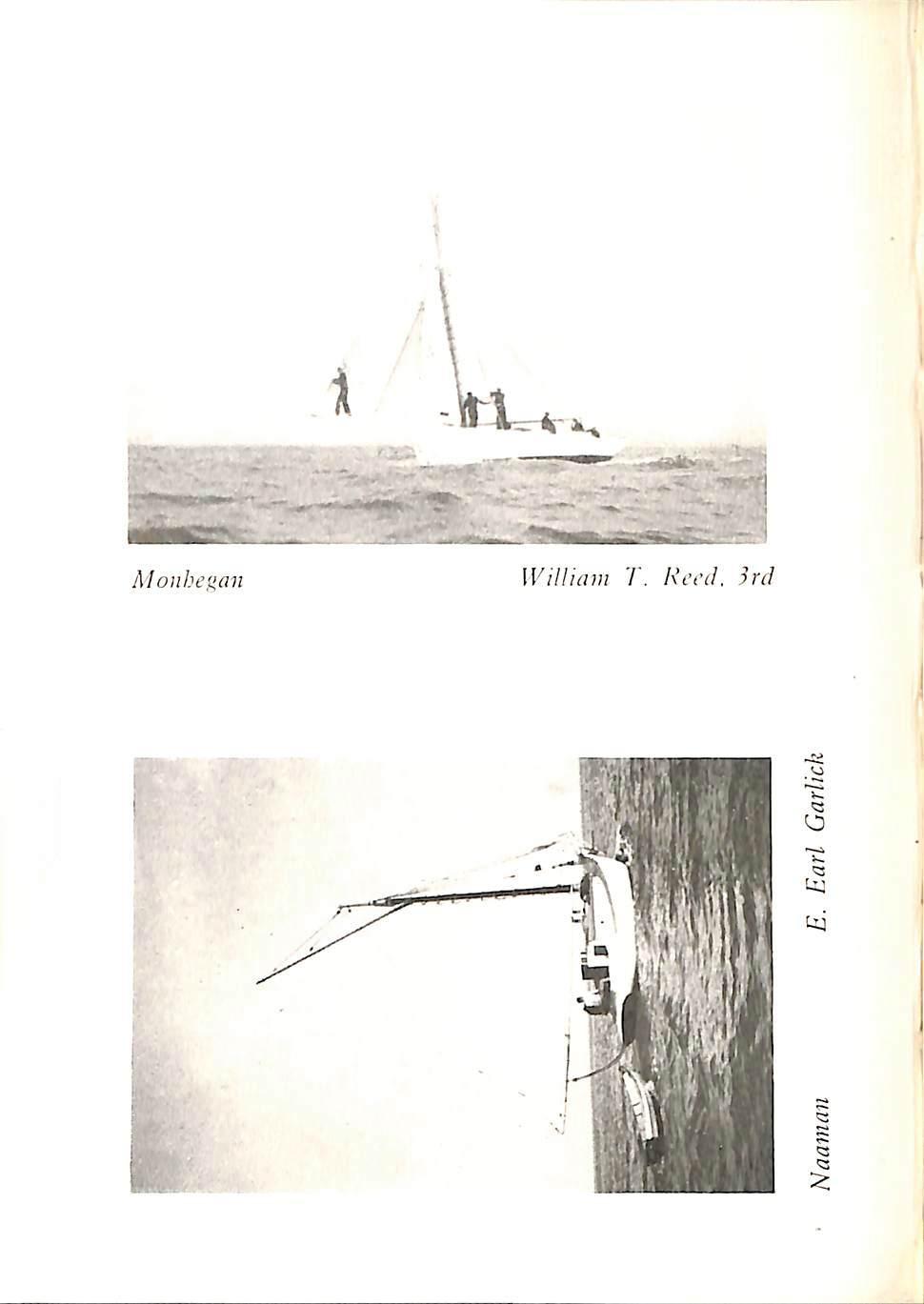





 Hiirpoon II
Hiirpoon II





 Viclorv III
George E. Rice
Viclorv III
George E. Rice




